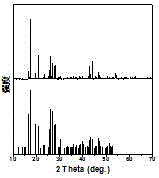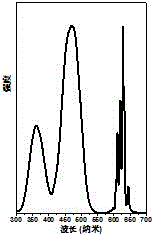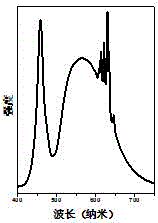Preparation method of fluoride red phosphor used for blue-light semiconductor light emitting diode
A technology of light-emitting diodes and semiconductors, applied in chemical instruments and methods, luminescent materials, etc., can solve the problems of harsh preparation conditions of phosphors and high prices of phosphors
- Summary
- Abstract
- Description
- Claims
- Application Information
AI Technical Summary
Problems solved by technology
Method used
Image
Examples
Embodiment 1
[0018] Weigh 0.332 g and Nb 2 o 5 Dissolve in 2.5ml hydrofluoric acid (40wt%), stir at room temperature for 60 minutes until completely dissolved, add 0.062g potassium hexafluoromanganate to this solution and react for 30 minutes; then add 0.145g potassium fluoride solid and continue stirring for 50 minutes. The resulting precipitate was washed 3 times with anhydrous acetic acid and anhydrous methanol, and finally dried in a vacuum oven for 24 hours. The orange-red powder obtained was the final product K 2 NbF 7 :Mn 4+ .
[0019] The XRD diffraction pattern of this fluorescent powder is attached figure 1 shown, with standard card JCPDS 22-0839 (K 2 NbF 7 ) in contrast, the two are completely consistent, and no diffraction peaks of any heterogeneous phases are observed, which indicates that the samples we synthesized have a single crystal phase.
[0020] attached figure 2 Shown are the room temperature excitation spectrum (monitored at 628 nm) and emission spectrum (ex...
Embodiment 2
[0023] Weigh 0.552 g and Ta 2 o 5 Dissolve in 2.5ml hydrofluoric acid (40wt%), stir at room temperature for 40 minutes until completely dissolved, add 0.016g potassium hexafluoromanganate to this solution and react for 40 minutes; then add 0.145g potassium fluoride solid and continue stirring for 60 minutes. The resulting precipitate was washed 3 times with anhydrous acetic acid and anhydrous methanol, and finally dried in a vacuum oven for 24 hours. The orange-red powder obtained was the final product K 2 TaF 7 :Mn 4+ .
[0024] The XRD diffraction pattern of this fluorescent powder is attached Figure 4 shown, with the standard card JCPDS 84-1255 (K 2 TaF 7 ) consistent, our synthesized samples have a single crystal phase.
[0025] attached Figure 5 Shown are the room temperature excitation spectrum (monitored at 626 nm) and emission spectrum (excited at 485 nm) of the sample. The sample has strong broadband excitation in both ultraviolet and blue light regions. U...
Embodiment 3
[0028] Weigh 0.332 g and Nb 2 o 5Dissolve in 2.5ml hydrofluoric acid (40wt%), stir at room temperature for 50 minutes until completely dissolved, add 0.016g potassium hexafluoromanganate to this solution and react for 40 minutes; then add 0.290g potassium fluoride solid and continue stirring for 50 minutes. The resulting precipitate was washed 3 times with anhydrous acetic acid and anhydrous methanol, and finally dried in a vacuum oven for 24 hours. The orange-red powder obtained was the final product K 2 NbF 7 :Mn 4+ .
PUM
| Property | Measurement | Unit |
|---|---|---|
| wavelength | aaaaa | aaaaa |
Abstract
Description
Claims
Application Information
 Login to View More
Login to View More - R&D
- Intellectual Property
- Life Sciences
- Materials
- Tech Scout
- Unparalleled Data Quality
- Higher Quality Content
- 60% Fewer Hallucinations
Browse by: Latest US Patents, China's latest patents, Technical Efficacy Thesaurus, Application Domain, Technology Topic, Popular Technical Reports.
© 2025 PatSnap. All rights reserved.Legal|Privacy policy|Modern Slavery Act Transparency Statement|Sitemap|About US| Contact US: help@patsnap.com



